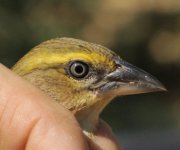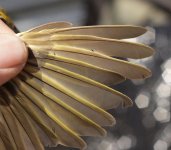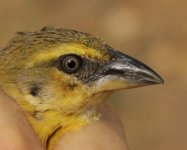tomjenner
Well-known member
I was ringing some Northern Masked Weavers today and I had my first opportunity to handle some juveniles. I have not worked with juvenile passerines for many years, but I assumed the ID of juveniles would be easy. However, I found myself a bit confused, especially with birds that were moulting flight feathers and had pale eyes (as I had, perhaps foolishly, assumed the lighter coloured eyes would the older birds). Many of the birds had a distinct gape flange, which I remember from many years ago being a good indicator of a juvenile, but I am wondering how certain it is.
There is little information on weaver moult, but it seems that many have a complete post-juvenile moult, so it may be that my confusing birds were early fledgelings that have already developed a pale eye and are moulting, yet still have the gape flange.
The first two photos show the head and wing of one of these confusing birds. The moulting remiges show a distinct difference between the older pale brown feathers and the newer ones, which made me first think it was an older bird. However the head shot seems to show a distinct gape flange. Also, the older unmoulted feathers show little wear, which would indicate that it might be a juvenile. Many of the adults caught today had very abraded tips to their primaries. I have also attached a photo of a known adult for comparison, which was trapped near the start of the breeding season in May when there would be no juveniles around.
I would appreciate your comments on my identification of the first bird as a juvenile based on the gape flange. I did not record skull ossification.
Thanks
Tom
There is little information on weaver moult, but it seems that many have a complete post-juvenile moult, so it may be that my confusing birds were early fledgelings that have already developed a pale eye and are moulting, yet still have the gape flange.
The first two photos show the head and wing of one of these confusing birds. The moulting remiges show a distinct difference between the older pale brown feathers and the newer ones, which made me first think it was an older bird. However the head shot seems to show a distinct gape flange. Also, the older unmoulted feathers show little wear, which would indicate that it might be a juvenile. Many of the adults caught today had very abraded tips to their primaries. I have also attached a photo of a known adult for comparison, which was trapped near the start of the breeding season in May when there would be no juveniles around.
I would appreciate your comments on my identification of the first bird as a juvenile based on the gape flange. I did not record skull ossification.
Thanks
Tom
Attachments
Last edited:







